Abstract
Denervation of the hippocampal formation in adult rats through lesion of the medial septum and diagonal band or by transection of the fimbria/fornix elicits an increase in the number of putative alpha-adrenergic receptor binding sites labeled by the antagonist ligand [3H]WB4101 [2-(2,6-dimethoxyphenoxyethyl)-aminomethyl-1,4-benzodioxane]. This increase in [3H]WB4101 binding is observable at 6 days postlesion, preceding the ingrowth of sympathetic axons into the partially denervated regions of the hippocampus. The receptor up-regulation is specific for lesions of the septal (primarily cholinergic) innervation of the hippocampus. Damage to noradrenergic, dopaminergic, or serotonergic afferents as well as kainate injections in the lateral septum had no effect on [3H]WB4101 binding levels. In vivo muscarinic/cholinergic-receptor blockade does not mimic the effects of the lesion on receptor binding levels or upon axonal sprouting of the sympathetic neurons. Although [3H]WB4101 binding consistently increased after septal deafferentation, there was no clear-cut effect upon the other adrenergic ligands, including [3H]prazosin, [3H]yohimbine, P-[3H]aminoclonidine, or [3H]dihydroalprenolol. These observations can be interpreted as demonstrating a unique and selective adrenergic receptor increase after a nonadrenergic denervation but accompanying the ingrowth of anomalous adrenergic fibers. We suggest several possible relationships between the new binding sites and the ingrowing axons.
Full text
PDF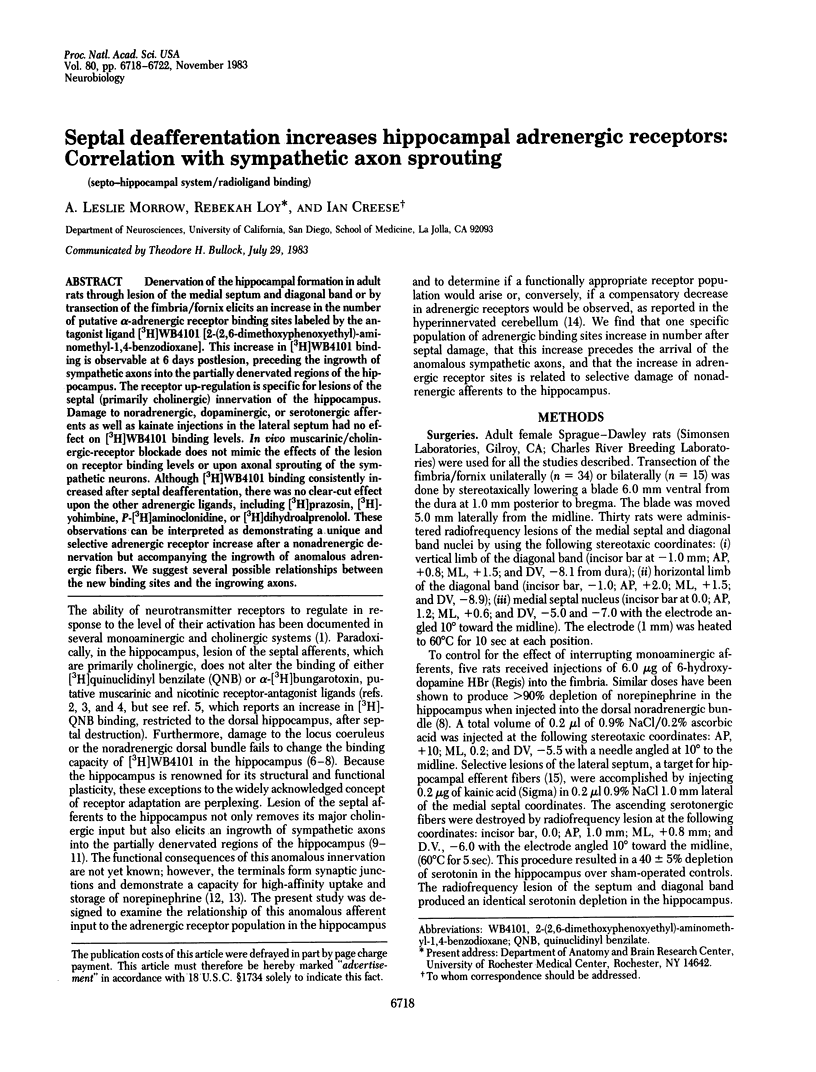
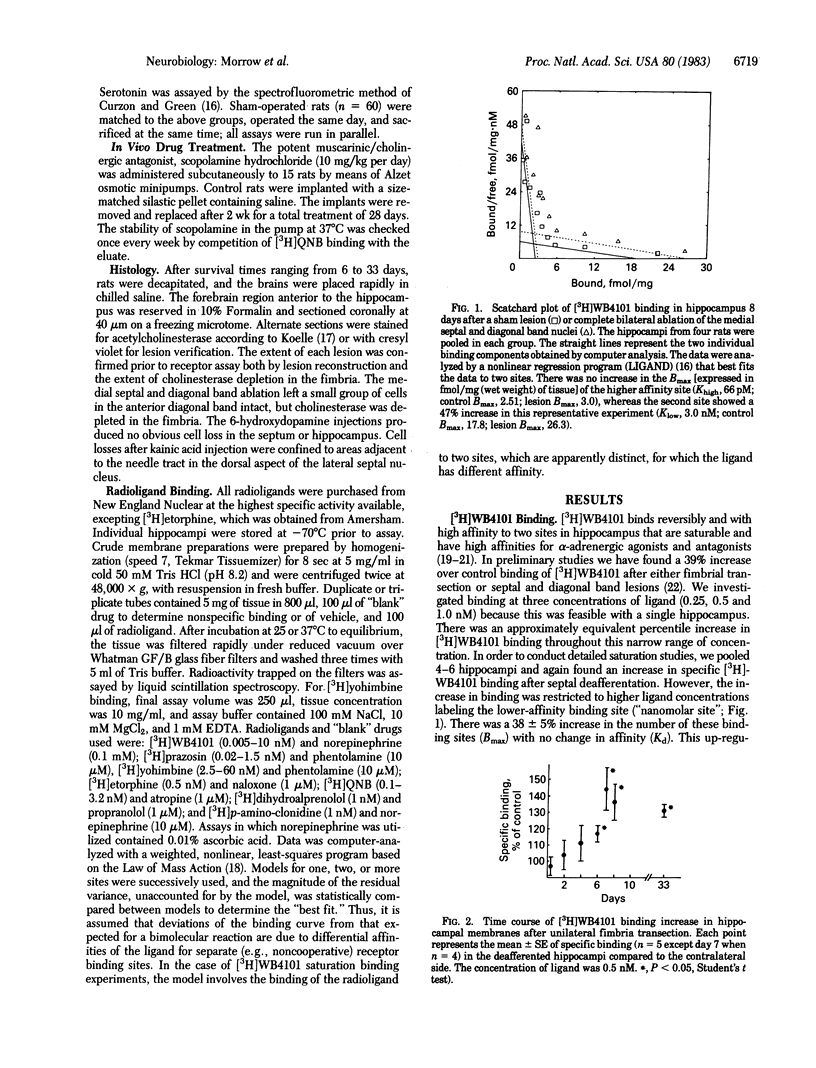
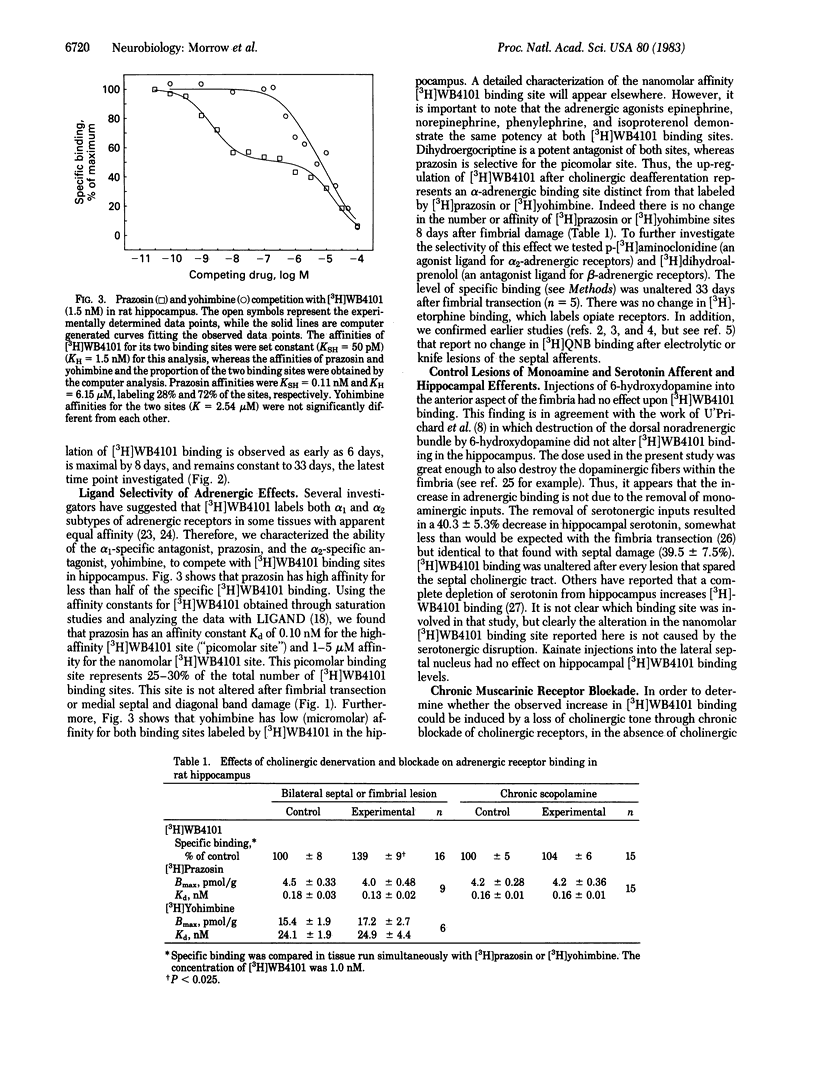
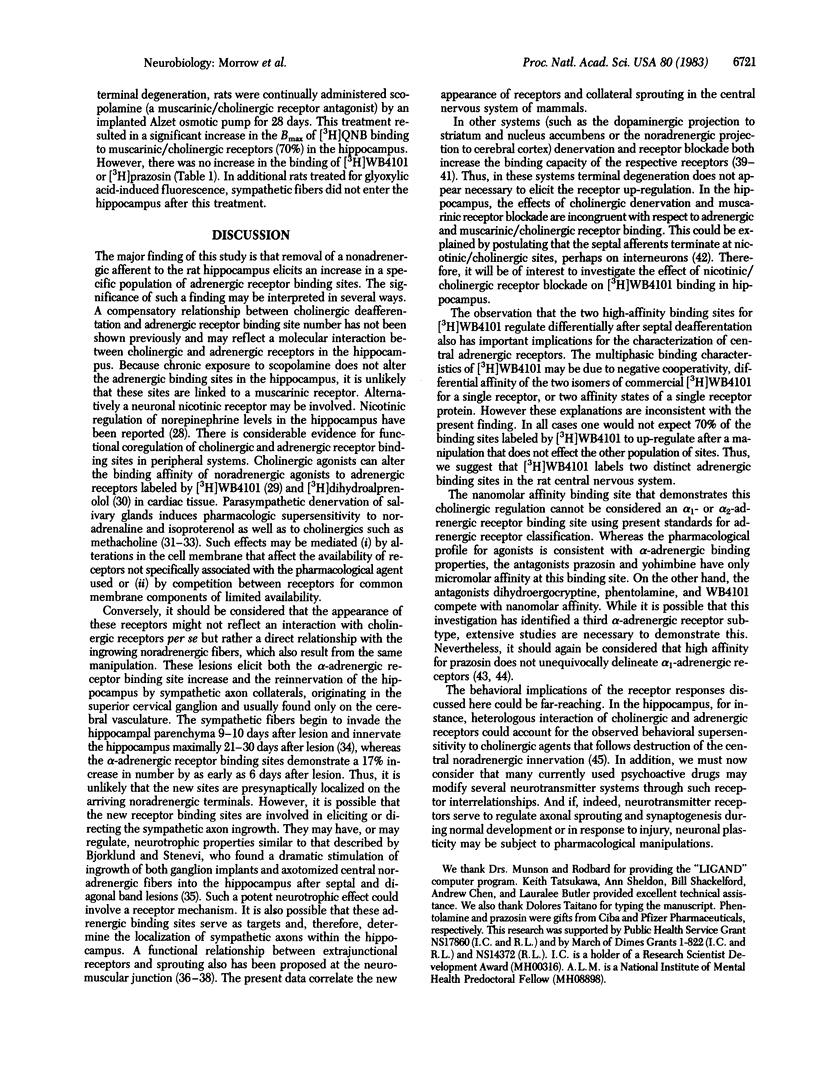
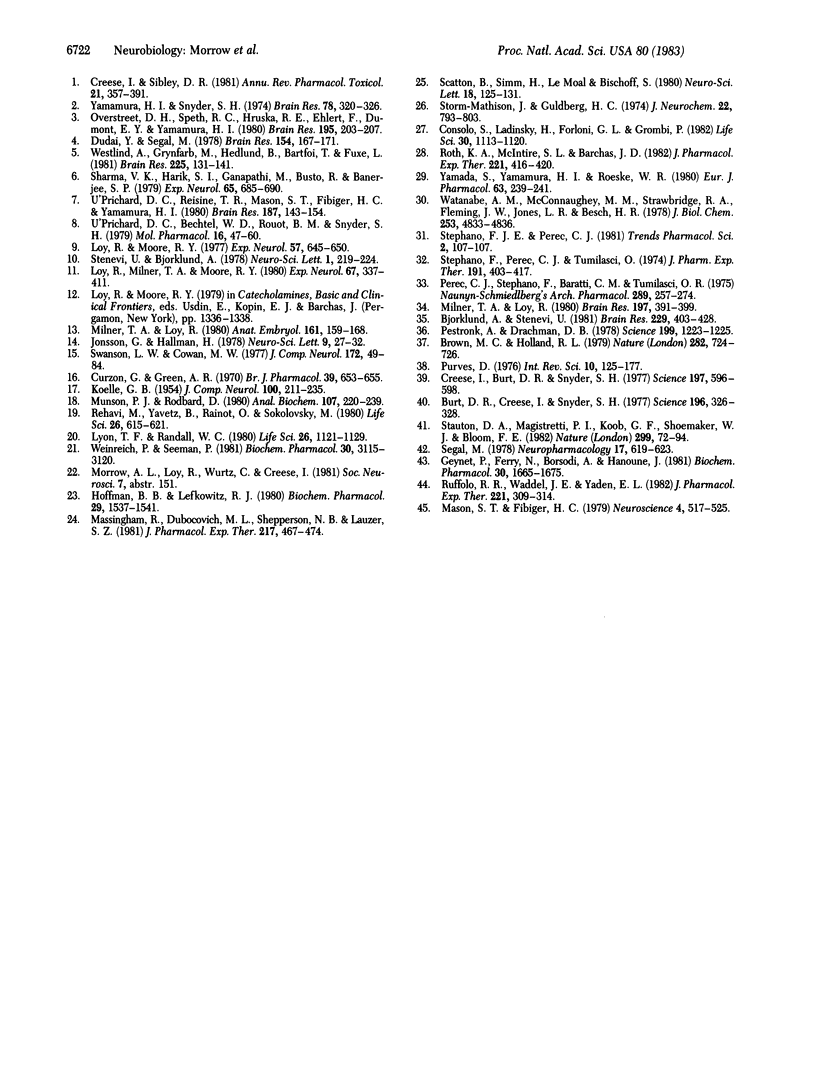
Selected References
These references are in PubMed. This may not be the complete list of references from this article.
- Björklund A., Stenevi U. In vivo evidence for a hippocampal adrenergic neuronotrophic factor specifically released on septal deafferentation. Brain Res. 1981 Dec 21;229(2):403–428. doi: 10.1016/0006-8993(81)91004-0. [DOI] [PubMed] [Google Scholar]
- Brown M. C., Holland R. L. A central role for denervated tissues in causing nerve sprouting. Nature. 1979 Dec 13;282(5740):724–726. doi: 10.1038/282724a0. [DOI] [PubMed] [Google Scholar]
- Burt D. R., Creese I., Snyder S. H. Antischizophrenic drugs: chronic treatment elevates dopamine receptor binding in brain. Science. 1977 Apr 15;196(4287):326–328. doi: 10.1126/science.847477. [DOI] [PubMed] [Google Scholar]
- Consolo S., Ladinsky H., Forloni G. L., Grombi P. Modulation of the hippocampal alpha-adrenoceptor population by lesion of the serotonergic raphe-hippocampal pathway in rats. Life Sci. 1982 Mar 29;30(13):1113–1120. doi: 10.1016/0024-3205(82)90532-x. [DOI] [PubMed] [Google Scholar]
- Creese I., Burt D. R., Snyder S. H. Dopamine receptor binding enhancement accompanies lesion-induced behavioral supersensitivity. Science. 1977 Aug 5;197(4303):596–598. doi: 10.1126/science.877576. [DOI] [PubMed] [Google Scholar]
- Creese I., Sibley D. R. Receptor adaptations to centrally acting drugs. Annu Rev Pharmacol Toxicol. 1981;21:357–391. doi: 10.1146/annurev.pa.21.040181.002041. [DOI] [PubMed] [Google Scholar]
- Curzon G., Green A. R. Rapid method for the determination of 5-hydroxytryptamine and 5-hydroxyindoleacetic acid in small regions of rat brain. Br J Pharmacol. 1970 Jul;39(3):653–655. doi: 10.1111/j.1476-5381.1970.tb10373.x. [DOI] [PMC free article] [PubMed] [Google Scholar]
- Dudai Y., Segal M. alpha-Bungarotoxin binding sites in rat hippocampus: localization in postynaptic cells. Brain Res. 1978 Oct 6;154(1):167–171. doi: 10.1016/0006-8993(78)91066-1. [DOI] [PubMed] [Google Scholar]
- Geynet P., Ferry N., Borsodi A., Hanoune J. Two distinct alpha1-adrenergic receptor sites in rat liver: differential binding of (--)-[3H]dihydroergocryptine. Effects of guanine nucleotides and proteolysis; implications for a two-site model of alpha-receptor regulation. Biochem Pharmacol. 1981 Jun 15;30(12):1665–1675. doi: 10.1016/0006-2952(81)90395-6. [DOI] [PubMed] [Google Scholar]
- Hoffman B. B., Lefkowitz R. J. [3H]WB4101--caution about its role as an alpha-adrenergic subtype selective radioligand. Biochem Pharmacol. 1980 Jun 1;29(11):1537–1541. doi: 10.1016/0006-2952(80)90605-x. [DOI] [PubMed] [Google Scholar]
- KOELLE G. B. The histochemical localization of cholinesterases in the central nervous system of the rat. J Comp Neurol. 1954 Feb;100(1):211–235. doi: 10.1002/cne.901000108. [DOI] [PubMed] [Google Scholar]
- Loy R., Moore R. Y. Anomalous innervation of the hippocampal formation by peripheral sympathetic axons following mechanical injury. Exp Neurol. 1977 Nov;57(2):645–650. doi: 10.1016/0014-4886(77)90096-6. [DOI] [PubMed] [Google Scholar]
- Lyon T. F., Randall W. C. Multiple central WB-4101 binding sites and the selectivity of prazosin. Life Sci. 1980 Apr 7;26(14):1121–1129. doi: 10.1016/0024-3205(80)90651-7. [DOI] [PubMed] [Google Scholar]
- Mason S. T., Fibiger H. C. Interaction between noradrenergic and cholinergic systems in the rat brain: behavioural function in locomotor activity. Neuroscience. 1979;4(4):517–525. doi: 10.1016/0306-4522(79)90128-3. [DOI] [PubMed] [Google Scholar]
- Massingham R., Dubocovich M. L., Shepperson N. B., Langer S. Z. In vivo selectivity of prazosin but not of WB4101 for postsynaptic alpha-1 adrenoceptors. J Pharmacol Exp Ther. 1981 May;217(2):467–474. [PubMed] [Google Scholar]
- Milner T. A., Loy R. A delayed sprouting response to partial hippocampal deafferentation: time course of sympathetic ingrowth following fimbrial lesions. Brain Res. 1980 Sep 22;197(2):391–399. doi: 10.1016/0006-8993(80)91124-5. [DOI] [PubMed] [Google Scholar]
- Milner T. A., Loy R. Interaction of age and sex in sympathetic axon ingrowth into the hippocampus following septal afferent damage. Anat Embryol (Berl) 1980;161(2):159–168. doi: 10.1007/BF00305342. [DOI] [PubMed] [Google Scholar]
- Munson P. J., Rodbard D. Ligand: a versatile computerized approach for characterization of ligand-binding systems. Anal Biochem. 1980 Sep 1;107(1):220–239. doi: 10.1016/0003-2697(80)90515-1. [DOI] [PubMed] [Google Scholar]
- Overstreet D. H., Speth R. C., Hruska R. E., Ehlert F., Dumont Y., Yamamura H. I. Failure of septal lesions to alter muscarinic cholinergic or benzodiazepine binding sites in hippocampus of rat brain. Brain Res. 1980 Aug 11;195(1):203–207. doi: 10.1016/0006-8993(80)90878-1. [DOI] [PubMed] [Google Scholar]
- Perec C. J., Stefano F. J., Baratti C. M., Tumilasci O. R. Effects of 6-hydroxydopamine Treatment at birth on the submaxillary gland of the rat. Naunyn Schmiedebergs Arch Pharmacol. 1975;289(3):257–274. doi: 10.1007/BF00499980. [DOI] [PubMed] [Google Scholar]
- Pestronk A., Drachman D. B. Motor nerve sprouting and acetylcholine receptors. Science. 1978 Mar 17;199(4334):1223–1225. doi: 10.1126/science.204007. [DOI] [PubMed] [Google Scholar]
- Rehavi M., Yavetz B., Ramot O., Sokolovsky M. Regional heterogeneity of two high affinity binding sites for 3H-WB-4101 in mouse brain. Life Sci. 1980 Feb 25;26(8):615–621. doi: 10.1016/0024-3205(80)90237-4. [DOI] [PubMed] [Google Scholar]
- Roth K. A., McIntire S. L., Barchas J. D. Nicotinic-catecholaminergic interactions in rat brain: evidence for cholinergic nicotinic and muscarinic interactions with hypothalamic epinephrine. J Pharmacol Exp Ther. 1982 May;221(2):416–420. [PubMed] [Google Scholar]
- Ruffolo R. R., Jr, Waddell J. E., Yaden E. L. Heterogeneity of postsynaptic Alpha adrenergic receptors in mammalian aortas. J Pharmacol Exp Ther. 1982 May;221(2):309–314. [PubMed] [Google Scholar]
- Scatton B., Simon H., Le Moal M., Bischoff S. Origin of dopaminergic innervation of the rat hippocampal formation. Neurosci Lett. 1980 Jun;18(2):125–131. doi: 10.1016/0304-3940(80)90314-6. [DOI] [PubMed] [Google Scholar]
- Segal M. The acetylcholine receptor in the rat hippocampus; nicotinic, muscarinic or both? Neuropharmacology. 1978 Aug;17(8):619–623. doi: 10.1016/0028-3908(78)90157-0. [DOI] [PubMed] [Google Scholar]
- Sharma V. K., Harik S. I., Ganapathi M., Busto R., Banerjee S. P. Locus ceruleus lesion and chronic reserpine treatment: effect on adrenergic and cholinergic receptors in cerebral cortex and hippocampus. Exp Neurol. 1979 Sep;65(3):685–689. doi: 10.1016/0014-4886(79)90054-2. [DOI] [PubMed] [Google Scholar]
- Staunton D. A., Magistretti P. J., Koob G. F., Shoemaker W. J., Bloom F. E. Dopaminergic supersensitivity induced by denervation and chronic receptor blockade is additive. Nature. 1982 Sep 2;299(5878):72–74. doi: 10.1038/299072a0. [DOI] [PubMed] [Google Scholar]
- Stefano F. J., Perec C. J., Tumilasci O. R. Changes in neuronal uptake and metabolism of, and sensitivity to, norepinephrine during the degeneration secretion in the rat submaxillary gland. J Pharmacol Exp Ther. 1974 Dec;191(3):403–417. [PubMed] [Google Scholar]
- Storm-Mathisen J., Guldberg H. C. 5-Hydroxytryptamine and noradrenaline in the hippocampal region: effect of transection of afferent pathways on endogenous levels, high affinity uptake and some transmitter-related enzymes. J Neurochem. 1974 May;22(5):793–803. doi: 10.1111/j.1471-4159.1974.tb04297.x. [DOI] [PubMed] [Google Scholar]
- Swanson L. W., Cowan W. M. An autoradiographic study of the organization of the efferent connections of the hippocampal formation in the rat. J Comp Neurol. 1977 Mar 1;172(1):49–84. doi: 10.1002/cne.901720104. [DOI] [PubMed] [Google Scholar]
- U'Prichard D. C., Bechtel W. D., Rouot B. M., Snyder S. H. Multiple apparent alpha-noradrenergic receptor binding sites in rat brain: effect of 6-hydroxydopamine. Mol Pharmacol. 1979 Jul;16(1):47–60. [PubMed] [Google Scholar]
- U'Prichard D. C., Reisine T. D., Mason S. T., Fibiger H. C., Yamamura H. I. Modulation of rat brain alpha- and beta-adrenergic receptor populations by lesion of the dorsal noradrenergic bundle. Brain Res. 1980 Apr 7;187(1):143–154. doi: 10.1016/0006-8993(80)90500-4. [DOI] [PubMed] [Google Scholar]
- Watanabe A. M., McConnaughey M. M., Strawbridge R. A., Fleming J. W., Jones L. R., Besch H. R., Jr Muscarinic cholinergic receptor modulation of beta-adrenergic receptor affinity for catecholamines. J Biol Chem. 1978 Jul 25;253(14):4833–4836. [PubMed] [Google Scholar]
- Weinreich P., Seeman P. Binding of adrenergic ligands ([3H]clonidine and [3H]WB-4101) to multiple sites in human brain. Biochem Pharmacol. 1981 Nov 15;30(22):3115–3120. doi: 10.1016/0006-2952(81)90502-5. [DOI] [PubMed] [Google Scholar]
- Westlind A., Grynfarb M., Hedlund B., Bartfai T., Fuxe K. Muscarinic supersensitivity induced by septal lesion or chronic atropine treatment. Brain Res. 1981 Nov 23;225(1):131–141. doi: 10.1016/0006-8993(81)90323-1. [DOI] [PubMed] [Google Scholar]
- Yamada S., Yamamura H. I., Roeske W. R. The regulation of cardiac alpha 1-adrenergic receptors by guanine nucleotides and by muscarinic cholinergic agonists. Eur J Pharmacol. 1980 May 2;63(2-3):239–241. doi: 10.1016/0014-2999(80)90455-0. [DOI] [PubMed] [Google Scholar]
- Yamamura H. I., Snyder S. H. Postsynaptic localization of muscarinic cholinergic receptor binding in rat hippocampus. Brain Res. 1974 Sep 27;78(2):320–326. doi: 10.1016/0006-8993(74)90556-3. [DOI] [PubMed] [Google Scholar]


